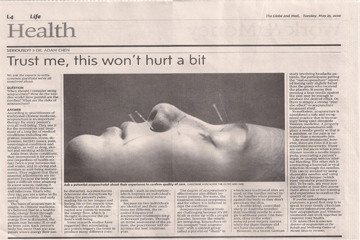Acupuncture? Trust me, this won't hurt a bit

Adam Chen
Globe and Mail Update
Published
QUESTION
When should I consider using acupuncture? How do the needles work? How painful are the needles? What are the risks of acupuncture?
ANSWER
According to practitioners of traditional Chinese medicine, acupuncture is an important therapy for every person’s overall well-being. They use it for the prevention and treatment of a long list of medical conditions including migraines,
Aside from these conditions, they recommend it for everyone (regardless of health status) twice a year between fall and winter, and in spring and summer as well-being maintenance. They suggest that these seasonal adjustments are important because the body can have a difficult time adapting to a new season, making it more vulnerable to diseases and infections. That’s why, they say, you see a spike in flu cases in late winter and early spring.
The basis of acupuncture is simple. In Chinese medicine, it’s believed that in a healthy body, energy flows through channels smoothly. If that energy flow is disrupted, the person may become ill or suffer from pain. Each person’s body has more than 300 acu-points where energy flow can be disrupted. Acupuncturists determine the disruptions by taking the patient’s pulse, reading his or her tongue and feeling his or her muscle tone. Needles are placed at the disrupted acu-points to resume the energy flow, which is thought to improve the patient’s well-being.
Some research studies have suggested that stimulating acu-points triggers the brain to produce many different compounds – such as endorphins – which improve an individual’s disease condition or reduce pain.
Because no two individuals are identical and their conditions are different, the required frequency of acupuncture treatments ranges between patients. Through an initial assessment of the patient, the practitioner will determine the best treatment plan.
The degree of acupuncture’s effectiveness also differs between patients. For some, the treatment reduces symptoms, and for others it is believed to cure the condition.
Acupuncture clinical trials are challenging because it’s difficult to come up with a proper placebo; however the results are intriguing. Researchers often compare “real acupuncture” with a control group called a placebo or “sham” in which non-traditional sites are used, or the needles retract into the handles when pressed against the body so they don’t penetrate the skin.
A double-blind, controlled study in Australia revealed that inserting needle to a single traditional point (the forearm, close to the wrist) reduced post-surgery nausea, while the sham therapy did not have the same effect.
However, in a recent German study involving headache patients, the participants getting the “real acupuncture” reported feeling only slightly better than the group who received the placebo. It seems that pressing a faux needle against the skin may be enough to produce the desired effect. Or, there is simply a strong “placebo effect” to acupuncture treatment itself.
Nonetheless, acupuncture is considered a safe and recognized practice that is increasingly being used alongside Western medicine. A properly trained acupuncturist will place a needle gently so that it is painless, or the pain is no worse than a mosquito bite.
Like most treatments, however, there are risks if it is administered incorrectly. There are rare instances when a practitioner inserts a needle improperly, puncturing a patient’s organ or causing serious internal bleeding. The other risk is contracting a bacterial or viral infection through the needles. This can be avoided by using disposable needles and using the right technique (which most reputable practitioners do). To be safe, ask your acupuncturist at your first assessment about his or her training and experience to confirm the quality of care.
If you’re considering acupuncture, a good first step is to speak to your family physician for more information about how acupuncture and Western treatment can work together to improve your health.
Adam Chen is associate director of acupuncture at the Rehab and Wellbeing Centre of Mount Sinai in Toronto.






 Latest News
Latest News